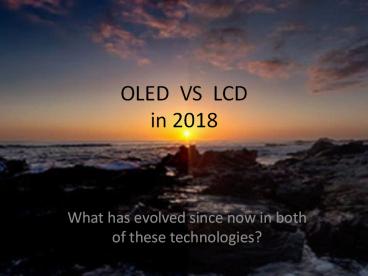OLED VS LCD in 2018 - PowerPoint PPT Presentation
Title:
OLED VS LCD in 2018
Description:
Earlier the LCD had an opposition with Plasma, yet now the Plasma is out of the opposition and is obsolete to utilize now. OLED is the new show innovation giving tuff rivalry to LCD and is demonstrated superior to anything LCD in numerous viewpoints as per the client audits. – PowerPoint PPT presentation
Number of Views:280
Title: OLED VS LCD in 2018
1
OLED VS LCD in 2018
- What has evolved since now in both of these
technologies?
2
Current Scenario in Display Technology
- Earlier the LCD had a competition with Plasma,
but now the Plasma is out of the competition and
is outdated to use now. OLED is the new display
technology giving tuff competition to LCD and is
proven better than LCD in many aspects according
to the user reviews.
PLASMA
OLED
3
How LCD works?
- We all know that a picture displayed on a
television consists of millions of pixels which
are either red, green or blue and they
collectively form a picture for us to see.
- In an LCD television, the pixels are switched on
or off electronically using liquid crystals to
rotate polarized light, it has a large bright
light that shines out toward the viewer and
liquid crystals manipulating It to create an
image.
Liquid Crystal Display
4
What powers OLED to display a crystal clear view ?
- OLEDs have layers of n-type and p-type
semiconductors, they use organic molecules to
produce their electrons and holes. A simple OLED
is made up of six different layers of
protective glass or plastic. The top layer is
called the seal and the bottom layer
the substrate.
- In between those layers, there's a negative
terminal (sometimes called the cathode) and
a positive terminal (called the anode). Finally,
in between the anode and cathode are two layers
made from organic molecules called the emissive
layer
Organic Light Emitting Diode
5
Which has a awesome Light output ?
- LCD gets the nod here specifically because the
whole screen can be brighter, a function of
its backlight. OLED can't do a full screen with
as much brightness. Full-screen brightness isn't
very important in the real world however, so this
category is a relatively hollow victory for LCD.
- Light output also plays a big part in High
Dynamic Range (HDR).
6
Which one takes the lead while considering Black
level?
- At the other side of light output is black level,
or how dark the TV can get. OLED wins here
because of its ability to turn off individual
pixels completely. It can produce truly perfect
black.
- The better LCDs have local dimming, where parts
of the screen can dim independently of others.
This isn't quite as good as per-pixel control
because the black areas still aren't absolutely
black, but it's better than nothing.
7
Which is the best when it comes to Contrast ratio?
- Here's where it comes together. Contrast ratio is
the difference between the brightest and the
darkest a TV can be. OLED is the winner here
because it can get extremely bright, plus it can
produce absolute black with no blooming. It has
the best contrast ratio of any modern display. - Contrast ratio is the most important aspect of
picture quality. A high contrast-ratio display
will look more realistic than one with a lower
contrast ratio.
8
Who ranks first in terms of Resolution?
- This one's easy. Both OLED and LCD are widely
available in Ultra HD 4K form. There are also
plenty of 1080p LCDs. Some older OLEDs are 1080p,
but new models are all 4K.
9
Which one is best at Refresh rate and motion blur?
- Refresh rate is important in reducing motion
blur, or the blurring of anything on screen that
moves (including the whole image if the camera
pans). Sadly, the current version of OLED has
motion blur, just like custom LCD screen that
makes both of them perform almost same in this
segment.
10
Which one performs in providing better HDR?
- There are both OLED and LCD models that are
HDR-compatible. The best HDR LCDs can produce
brighter highlights than OLED, but OLED still has
a better overall contrast ratio (dynamic range,
if you will) thanks to its better black level.
Which is to say, done well, both are good. You
need HDR content though.
Without HDR With HDR
11
Which has a better Viewing angle?
- One of the main downsides of LCD TVs is a change
in picture quality if you sit away from dead
center - A few LCDs use in-plane switching (IPS) panels,
which have better off-axis picture quality than
other kinds of LCDs, but don't look as good as
other LCDs, primarily due to a lower contrast
ratio, which enables OLED displays to score here.
12
Conclusion
- LCD dominates the market because it's cheap to
manufacture and delivers good enough picture
quality for just about everybody. But OLED wins
for overall picture quality, largely due to the
incredible contrast ratio.
13
Thank You.
A presentation by
Visit http//newvisiondisplay.com/































